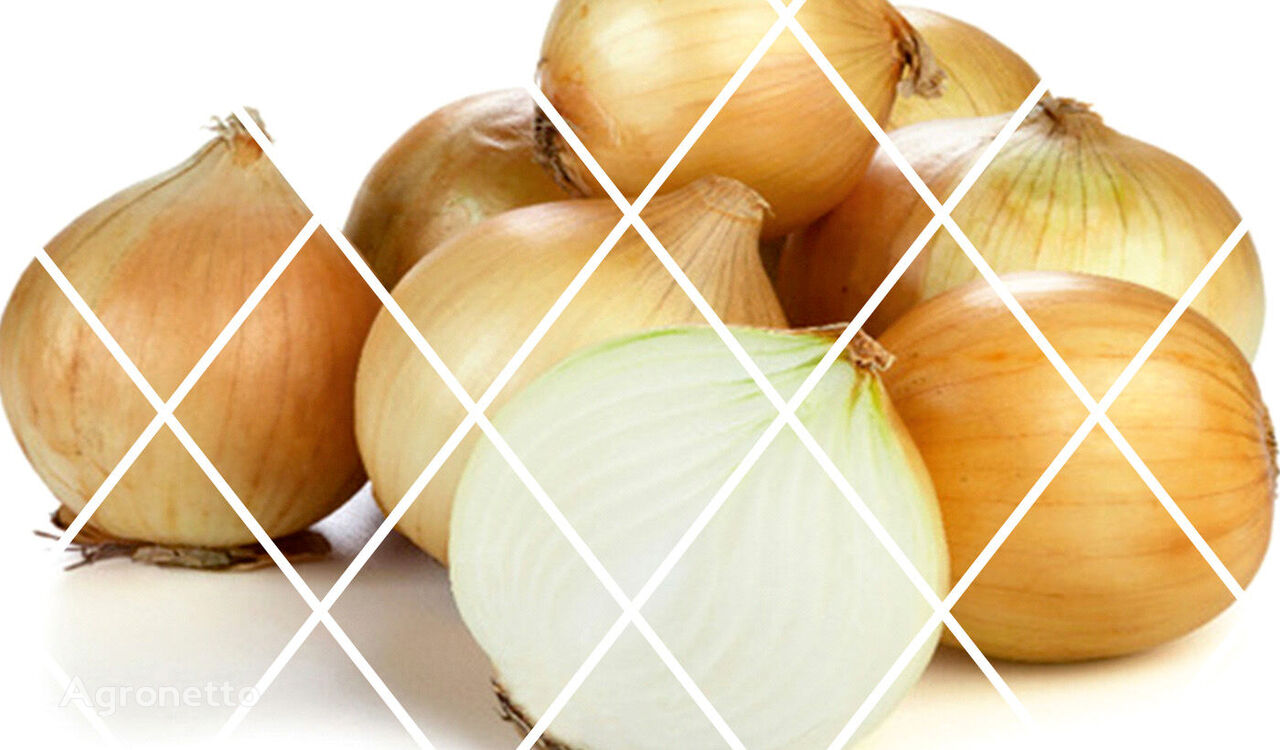Cebolla





Its close relatives include garlic, scallion, leek, chive,[4] and Chinese onion.[5]
This...
Its close relatives include garlic, scallion, leek, chive,[4] and Chinese onion.[5]
This genus also contains several other species variously referred to as onions and cultivated for food, such as the Japanese bunching onion (Allium fistulosum), the tree onion (A. ×proliferum), and the Canada onion (Allium canadense). The name wild onion is applied to a number of Allium species, but A. cepa is exclusively known from cultivation. Its ancestral wild original form is not known, although escapes from cultivation have become established in some regions.[6] The onion is most frequently a biennial or a perennial plant, but is usually treated as an annual and harvested in its first growing season.
The onion plant has a fan of hollow, bluish-green leaves and its bulb at the base of the plant begins to swell when a certain day-length is reached. The bulbs are composed of shortened, compressed, underground stems surrounded by fleshy modified scale (leaves) that envelop a central bud at the tip of the stem. In the autumn (or in spring, in the case of overwintering onions), the foliage dies down and the outer layers of the bulb become more dry and brittle. The crop is harvested and dried and the onions are ready for use or storage. The crop is prone to attack by a number of pests and diseases, particularly the onion fly, the onion eelworm, and various fungi which can cause rotting. Some varieties of A. cepa, such as shallots and potato onions, produce multiple bulbs.
Onions are cultivated and used around the world. As a food item, they are usually served cooked, as a vegetable or part of a prepared savory dish, but can also be eaten raw or used to make pickles or chutneys. They are pungent when chopped and contain certain chemical substances which may irritate the eyes.
Mezi jeho blízké příbuzné patří česnek, jarní cibulka, pórek, pažitka[4] a čínská cibule.[5]
Tento rod obsahuje také několik dalších druhů označovaných jako cibule a pěstovaných pro potravu, jako je japonská cibule trsnatá (Allium fistulosum), stromová cibule (A. ×proliferum) a kanadská cibule (Allium canadense). Název planá cibule se používá pro řadu druhů Allium, ale A. cepa je známá výhradně z pěstování. Jeho původní divoká forma předků není známa, i když se v některých regionech etablovaly úniky z pěstování.[6] Cibule je nejčastěji dvouletá nebo víceletá rostlina, ale obvykle se s ní zachází jako s jednoletou a sklízí se v prvním vegetačním období.
Cibule má vějíř dutých modrozelených listů a její cibulka na bázi rostliny začíná bobtnat, když dosáhne určité délky dne. Cibule se skládají ze zkrácených, stlačených podzemních stonků obklopených masitými upravenými šupinami (listy), které obalují centrální pupen na špičce stonku. Na podzim (nebo na jaře u přezimujících cibulí) olistění odumírá a vnější vrstvy cibule se stávají suchšími a křehčími. Plodina je sklizena a sušena a cibule jsou připraveny k použití nebo skladování. Plodina je náchylná k napadení řadou škůdců a chorob, zejména mouchou cibulovou, úhořem cibulovým a různými houbami, které mohou způsobit hnilobu. Některé odrůdy A. cepa, jako je šalotka a bramborová cibule, produkují více cibulek.
Cibule se pěstuje a používá po celém světě. Jako potravina se obvykle podávají vařené, jako zelenina nebo součást připraveného slaného pokrmu, ale lze je jíst i syrové nebo se z nich připravují okurky nebo chutney. Při nasekání jsou štiplavé a obsahují určité chemické látky, které mohou dráždit oči.
Ses proches parents comprennent l'ail, l'oignon vert, le poireau, la ciboulette[4] et l'oignon chinois.[5]
Ce genre contient également plusieurs autres espèces appelées oignons et cultivées à des fins alimentaires, comme l'oignon japonais (Allium fistulosum), l'oignon d'arbre (A. ×proliferum) et l'oignon du Canada (Allium canadense). Le nom d'oignon sauvage s'applique à un certain nombre d'espèces d'Allium, mais A. cepa est exclusivement connu par la culture. Sa forme originelle sauvage ancestrale n'est pas connue, bien que des échappées des cultures se soient établies dans certaines régions.[6] L'oignon est le plus souvent une plante bisannuelle ou vivace, mais il est généralement traité comme une plante annuelle et récolté lors de sa première saison de croissance.
La plante d'oignon a un éventail de feuilles creuses vert bleuâtre et son bulbe à la base de la plante commence à gonfler lorsqu'une certaine durée du jour est atteinte. Les bulbes sont composés de tiges souterraines raccourcies et comprimées entourées d'écailles charnues modifiées (feuilles) qui enveloppent un bourgeon central à l'extrémité de la tige. En automne (ou au printemps, dans le cas des oignons hivernants), le feuillage meurt et les couches externes du bulbe deviennent plus sèches et cassantes. La récolte est récoltée et séchée et les oignons sont prêts à être utilisés ou stockés. La culture est sujette aux attaques d'un certain nombre de ravageurs et de maladies, en particulier la mouche de l'oignon, l'anguille de l'oignon et divers champignons qui peuvent provoquer la pourriture. Certaines variétés d'A. cepa, comme les échalotes et les oignons pommes de terre, produisent plusieurs bulbes.
Les oignons sont cultivés et utilisés partout dans le monde. En tant qu'aliment, ils sont généralement servis cuits, comme légume ou dans un plat salé préparé, mais peuvent également être consommés crus ou utilisés pour faire des cornichons ou des chutneys. Ils sont piquants lorsqu'ils sont hachés et contiennent certaines substances chimiques susceptibles d'irriter les yeux.
Its close relatives include garlic, scallion, leek, chive,[4] and Chinese onion.[5]
This genus also contains several other species variously referred to as onions and cultivated for food, such as the Japanese bunching onion (Allium fistulosum), the tree onion (A. ×proliferum), and the Canada onion (Allium canadense). The name wild onion is applied to a number of Allium species, but A. cepa is exclusively known from cultivation. Its ancestral wild original form is not known, although escapes from cultivation have become established in some regions.[6] The onion is most frequently a biennial or a perennial plant, but is usually treated as an annual and harvested in its first growing season.
The onion plant has a fan of hollow, bluish-green leaves and its bulb at the base of the plant begins to swell when a certain day-length is reached. The bulbs are composed of shortened, compressed, underground stems surrounded by fleshy modified scale (leaves) that envelop a central bud at the tip of the stem. In the autumn (or in spring, in the case of overwintering onions), the foliage dies down and the outer layers of the bulb become more dry and brittle. The crop is harvested and dried and the onions are ready for use or storage. The crop is prone to attack by a number of pests and diseases, particularly the onion fly, the onion eelworm, and various fungi which can cause rotting. Some varieties of A. cepa, such as shallots and potato onions, produce multiple bulbs.
Onions are cultivated and used around the world. As a food item, they are usually served cooked, as a vegetable or part of a prepared savoury dish, but can also be eaten raw or used to make pickles or chutneys. They are pungent when chopped and contain certain chemical substances which may irritate the eyes.
Његови блиски сродници су бели лук, млади лук, празилук, власац[4] и кинески лук.[5]
Овај род такође садржи неколико других врста које се различито називају луком и узгајају за исхрану, као што су јапански лук (Аллиум фистулосум), црни лук (А. ×пролиферум) и канадски лук (Аллиум цанаденсе). Назив дивљи лук примењује се на бројне врсте Аллиум, али је А. цепа позната искључиво из узгоја. Његов предак дивљи изворни облик није познат, иако су у неким регионима успостављена бекства од узгоја.[6] Лук је најчешће двогодишња или вишегодишња биљка, али се обично третира као једногодишња и бере се у првој сезони раста.
Биљка лука има лепезу шупљих, плавкасто-зелених листова, а луковица у дну биљке почиње да бубри када се достигне одређена дужина дана. Луковице се састоје од скраћених, сабијених, подземних стабљика окружених меснатим модификованим љускама (листовима) које обавијају централни пупољак на врху стабљике. У јесен (или у пролеће, у случају презимљавања лука), лишће одумире, а спољни слојеви луковице постају суви и ломљивији. Усев се бере и суши, а лук је спреман за употребу или складиштење. Култура је склона нападима бројних штеточина и болести, посебно лукове мухе, црве јегуље и разних гљива које могу изазвати труљење. Неке сорте А. цепа, као што су љутика и лук кромпира, дају више луковица.
Лук се узгаја и користи широм света. Као прехрамбени артикал, обично се служе кувани, као поврће или део припремљеног сланог јела, али се могу јести и сирови или користити за припрему киселих краставаца или чатнија. Оштре су када се исецкају и садрже одређене хемијске супстанце које могу иритирати очи.
Si decide comprar maquinaria a un precio inferior, póngase en contacto con el verdadero vendedor. Recopile toda la información que le sea posible sobre el propietario de la maquinaria. Una forma de engaño es presentarse como empresa. En caso de sospecha, infórmenos mediante el formulario de comentarios y sugerencias para que lo comprobemos.
Antes de confirmar una compra, revise detenidamente varias ofertas de venta para ver cuál es el precio medio del equipo elegido. Si el precio de la oferta que le interesa es mucho menor que el de ofertas similares, piénselo dos veces. Una diferencia de precio significativa puede conllevar a defectos ocultos o a un intento de fraude por parte del vendedor.
No compre productos cuyo precio diste mucho del precio medio de equipos similares.
No acepte compromisos dudosos o mercancías con prepago. Si no lo tiene claro, no dude en solicitar aclaraciones, pida fotos adicionales y documentos del equipo, compruebe la autenticidad de los mismos y pregunte todo lo necesario.
Esta es la forma más habitual de fraude. Ciertos vendedores pueden requerir una cantidad del pago por adelantado en concepto de «reserva» de su compra. Así, los estafadores perciben grandes cantidades de dinero y después desaparecen sin dejar huella.
- Transferencia de prepago a la tarjeta
- No realice un pago por adelantado sin documentación que confirme el proceso de transferencia de dinero, si durante la comunicación con el vendedor ha surgido alguna duda.
- Transferencia a una cuenta «fiduciaria»
- Dicha solicitud debe alarmarle, ya que en la mayoría de los casos se trata de fraudes.
- Transferencia a una cuenta de una empresa con un nombre similar
- Tenga cuidado, ya que los estafadores pueden ocultarse tras la identidad de empresas reconocidas, realizando modificaciones mínimas en su nombre. No transfiera dinero si tiene dudas sobre el nombre de la empresa.
- Sustitución de sus propios datos en la factura de una empresa real
- Antes de realizar una transferencia, asegúrese de que los datos especificados sean correctos y que aludan a la empresa en cuestión.
Contactos del vendedor



 Turquía
Turquía 




























